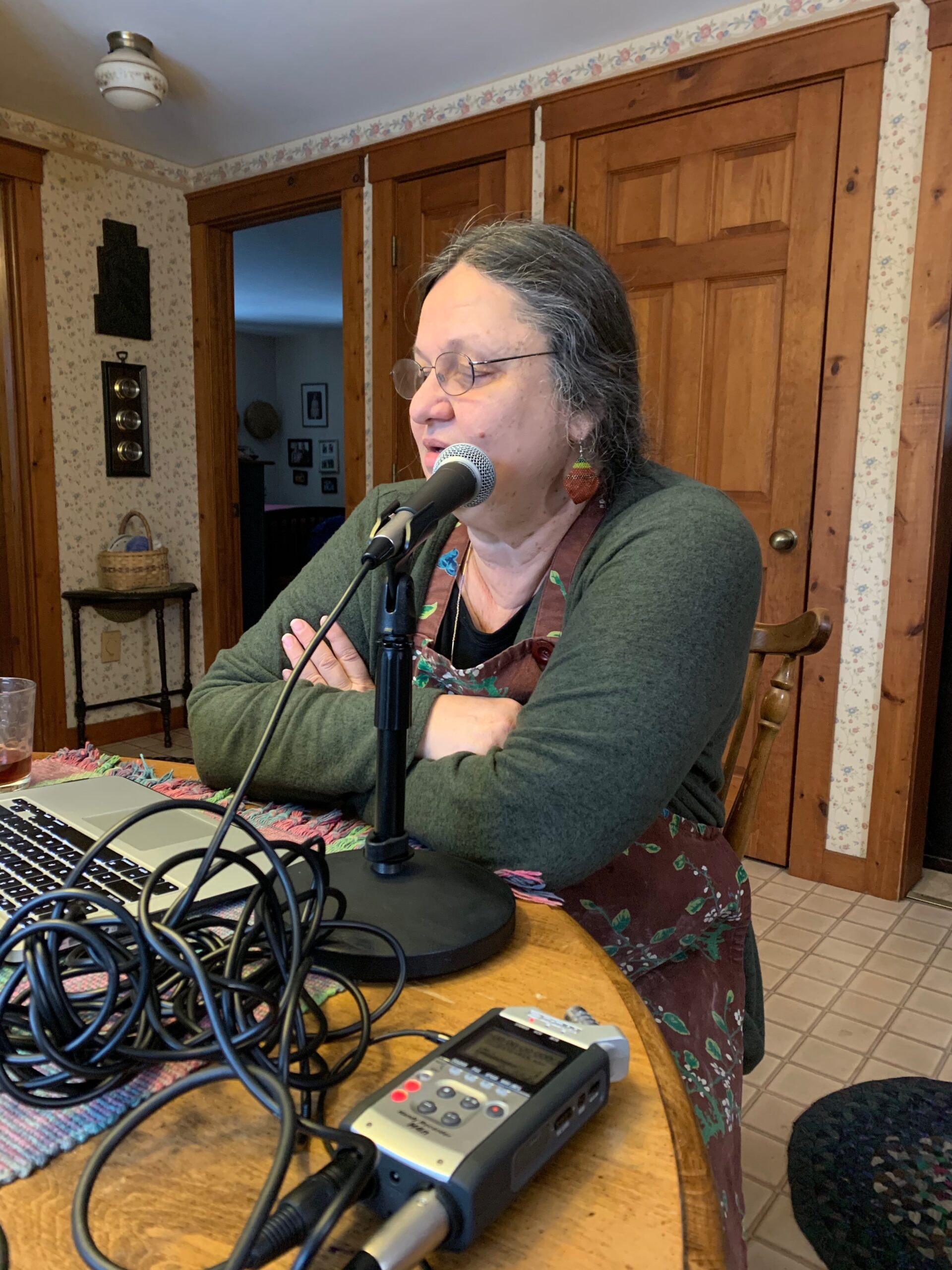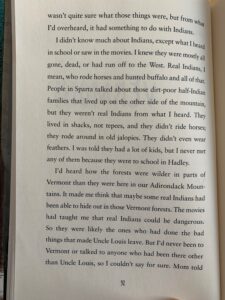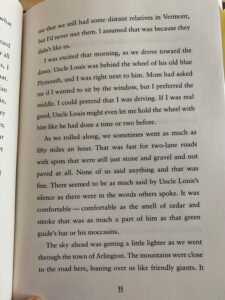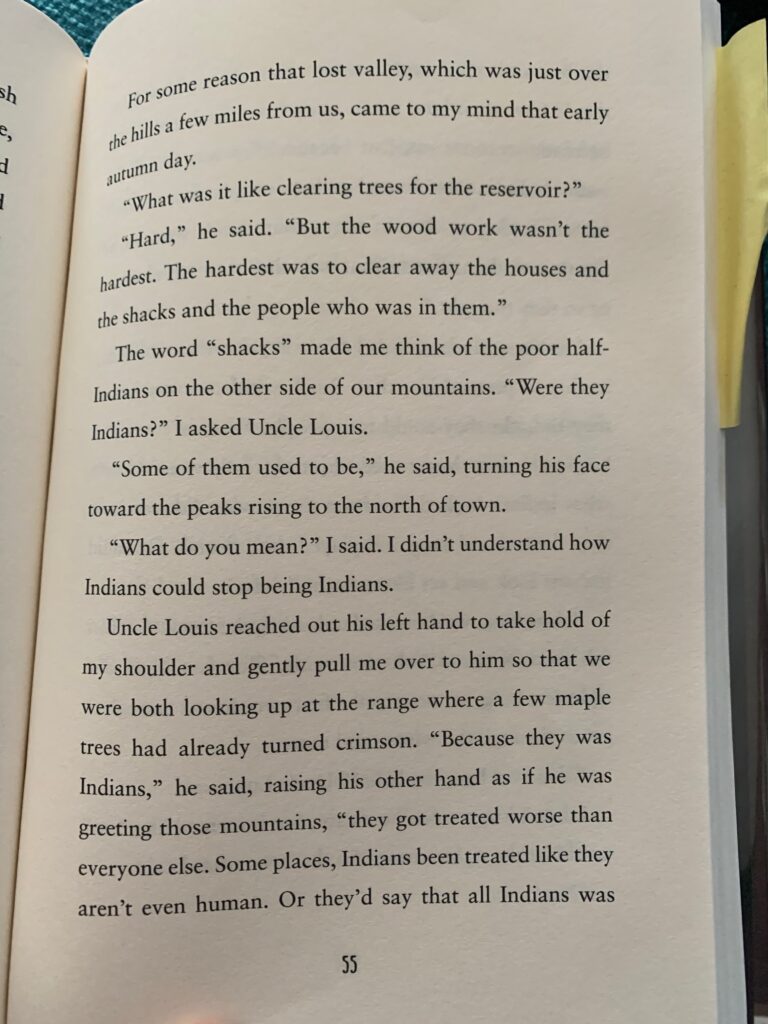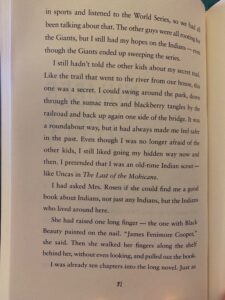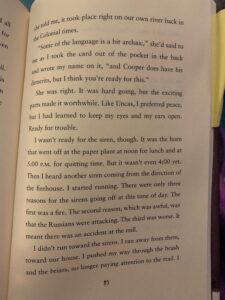On this episode of #vted Reads, we’re joined by noted Native scholar Judy Dow, to talk about Hidden Roots, by Joseph Bruchac.
This book and the issues it raises are incredibly important for us to address as both educators and Vermonters, given Vermont’s appalling history with eugenics. So as a quick content note: we’re going to be discussing family- and race-based trauma. Because we have to, so that you can talk about it with your students, and find new and better ways to incorporate the vibrant history of Indigenous and Native people — as well as including their voices and perspectives through the current day.
We got up early for this one, folks.
This is #vted Reads. Let’s chat.
Jeanie: I’m Jeanie Philips and welcome to #vted Reads. We are here to talk books for educators, by educators, and with educators. Today, I’m with Judy Dow and we’ll be talking about Hidden Roots by Joseph Bruchac.
Thank you for joining me Judy. Tell us a little bit about who you are and what you do.
Judy: Thank you, it’s nice to be here. Well, I’m currently working for Gedakina, a native organization that is throughout New England. And we have an educational component where we want to educate our students about culturally appropriate and historically accurate books. We want to educate other students that are not native about the same thing. Our hopes are this education will prevent bullying, or limit bullying, and a little bit more understanding between both cultural groups.
Through Gedakina, I’m working in the Windham Southeast Supervisory Union. It’s a district in the southeast corner of the state. We’re trying to develop a curriculum program that will match with H.3, the new bill that addresses ethnic studies being taught in core curriculum.
So the book I’m currently reading is one I read many, many times. It’s Hidden Roots by Joe Bruchac.
Jeanie: Excellent. I cannot tell you how excited I am to have you on the podcast. We’ve been friends since we took a trip together and you’re just a wealth of knowledge. I’m just so excited for this conversation. Thank you so much for joining me today. I always like to ask my guests, because I like to build my “to-be-read pile,” what they’re reading. Do you want to talk a little bit about, besides Hidden Roots, what you’ve been reading lately?
Judy: Sure. I’ve been trying to read a lot of old favorites so I could recommend them to teachers. And one of the children’s books that I’ve been reading (or re-reading) is March Toward the Thunder by Joe Bruchac. It is a civil war story about Abenaki boy who lies about his age and joins the Civil War to help his family find a place to live in Vermont.
Also Thanks to the Animals by Allen J. Sockabasin, which is a younger picture book about Zoo Sap, a little baby that falls off a sled and the animals care for him.
Muskrat Will Be Swimming by Cheryl Savageau is about bullying, name-calling, and it’s another very pertinent book for today.
And one of Joe’s new ones, Two Roads? Is about a young man who finds out he’s Choctaw from his father who is trying to hide it from him. They separate in life for Two Roads. The young boy has to go to a boarding school. The father goes to Washington to protest against the bonus checks from World War One. They want them earlier because it’s The Depression, and they’re losing their home.
I’m also reading Race Talk and the Conspiracy of Silence: Understanding and Facilitating Difficult Conversations on Race, by Derald Wing Sue. Very good, lots of vignettes that are based on classroom experiences. It’s very helpful.
The other one is White Fragility: Why It’s So Hard for White People to Talk About Racism by Robin DiAngelo. And that is also a very good book.
Jeanie: Those are excellent suggestions. I’m really excited to dig in.
I have some questions already, that aren’t even on our list of questions. The first one is I I wondered if you would talk about your identity. You used the word “Abenaki” ([ə̝ bɛn ə̝ki’] / “uhbENuhkey”). When I came to Vermont, I heard a lot about the “Abenaki” ([æ b’næ ki’] / “AbunAHkey”). You pronounce that word differently and I wondered if you want to talk about that.
Judy: Sure. So, the word Wabanahki describes the people of the Northeast. “Waban” is white, “Ahki” is land. People from the white land, or the dawn land, where the sun first rises. And the English pronounce that word as [æ b’næ ki’].
Along the Hudson River valley into New York were large Dutch settlements. And they said [ʊ b’næ ki’]. The French, however, had no sound for “w”. They took the word Wabanahki and made it [ə̝ bɛn ə̝ki’].
So you can tell someone’s ancestral background by how they pronounce the word. My first language is French so it’s pretty difficult for me to change [ə̝ bɛn ə̝ki’] to [æ b’næ ki’] at this point in my life.
Jeanie: How do you recommend that I as a white Vermonter pronounce the word?
Judy: I guess you could probably pronounce it any way you’d like. But you might want to ask the people you’re talking to what they would prefer to be called, because they may have a preference. They may prefer [ə̝ bɛn ə̝ki’] or [æ b’næ ki’] or Wabanahki. I think just simply asking them what they prefer would be the best way to handle it.
Jeanie: Great. During this podcast then I’m going to pronounce the word the way you pronounce it, and say [ə̝ bɛn ə̝ki’].
Judy: Sounds good!
Jeanie: Before we launch into Hidden Roots — which is just such a beautiful book — I had read it years ago. Before we get into the discussion of Hidden Roots, could you give us a little history of Vermont and the Native peoples who lived here?
I guess this is another place where I want to ask you about a preferred term. I have known folks in the past who preferred to be called Native Americans. I’ve known folks who preferred to be called Indians. I’ve known folks who preferred to be called just Native. I wonder if you could offer us a preferred term.
Judy: Well again, I know what I prefer but the person you’re speaking to may have a different preference, so it would be best to ask what they would prefer. But just as you might visit another place like Canada, you would say American, you are American.
Abenaki people might prefer to be called Abenaki. Mohawk people, Mohawk. The linguistic group they belong to is Iroquoian or Algonquian. You might refer to them as an Algonquin-speaking person, or a First Nations person, or an Indigenous person.
So I think the best thing is to ask what people would prefer to be called. Everybody has their different thoughts.
The term “Indian” is interesting for me. I’ve spoken to a lot of elders and asked them why they use the term Indian. They have often told me things like, “Well, all the books are written so that the stories are about Indians. I want my grandchildren to know and my great-grandchildren to know that those stories about us? *We* are the Indians they’re talking about.”
They frequently use the word Indian to discuss who they are and to self-identify with who they are for the purposes of allowing their grandchildren and great-grandchildren to know who their ancestors were.
Jeanie: So you’re making me think a lot about– I think especially in schools, right? We teach Native American units, say. And people use that phrase and it makes me wonder about the generalization when we use something like Indians or Native Americans.
Sometimes I’ve been using Indigenous more and I like the Canadian term, First Nations. What I like about First Nations is that it’s plural as opposed to grouping everyone together.
Judy: Yes. Sometimes Native Americans or American Indians are so generic. It leads people to believe that they’re all the same and they’re really not. Every nation is distinct and different in their ethics, morals and values. And that needs to reflect in what you call them.
That’s why it’s so important to call them by what they want to be referred to as.
And I think that Native American can refer to anyone born here as well. So that adds to the confusion. I think you see a lot more “American Indian” east of the Mississippi and “Native American” west of the Mississippi. So there’s differences across the country as well.
Jeanie: This is so helpful to me as I think about the way we teach. Especially thinking about this preference to ask people what they prefer to be called? I think one of the problems is that we often teach First Nations people as if they’re only in the past.
Judy: Yes. Correct. Which is very problematic because they still exist today and it’s the goal of this country to make us invisible so we eventually disappear. And by only talking about us in the past that’s exactly what happens, we become invisible.
Jeanie: That’s part of the problem.
Judy: Yes.
Jeanie: Oh my goodness, I could talk to you for days. Let’s jump into this book. Am I right that Joseph Bruchac is a friend of yours?
Judy: Yes. I’m working right now on a project to get him to come to the Windham Southeast Supervisory Union to do presentations for the students down there. I think the students will enjoy him and his son Jesse, and how they tell their stories. I think they could probably answer some questions for students about their writing.
Interview: Excellent. I would love to know more about that! Maybe I’ll try to spell for an invitation.
So Hidden Roots is set in the 1950s and I wondered if you would introduce us to Howie, the main character in the book.
Judy: Sure, Howie is an 11-year old boy who lives in Sparta, New York with his parents. And in this story it’s along the Hudson River. He’s sometimes called Sonny; it’s his nickname that he’s gotten because he’s the son of his father, right? And they are very much the same.
He has a troubled life because of a family secret that he hasn’t quite figured out yet. And his father is angry most of the time, for lots of reasons. But primarily there’s historical trauma being passed from one generation to the next generation, that’s not being addressed or talked about. And so there’s lots of lessons within this book.
Jeanie: Yes. Oof. I’m going ahead and read from page 32 of the book because it sets a nice scene for us about Howie’s relationship with his uncle Louis.
So, it’s early in the morning and Howie is sort of thinking through what he know about real Indians as he and Uncle Louis are visiting Vermont. And I think this really illuminates something you said earlier about the way we teach Indians and about erasure. I’m using that term Indians, I’m going to actually use the term Abenaki. And I wondered if you wanted to a little bit about the history of the Abenaki people in Vermont.
Judy: Yes. I can do that. But I want to just address Howie’s words first, if I could. Howie has come away with just about every stereotype you can think of, right? They’re dangerous. They’re ignorant, they just ride around in jalopies and live in shacks, they’re lazy and poor. And those stereotypes is what contributes to invisibility and problems.
At this point in the book, he has those stereotypes because that’s what he’s learned from the people around him. His family has not addressed the fact — the historical fact — that he’s actually an Indian. Or Native American, or Abenaki. They’ve not addressed any of that with him, that’s part of his family’s secret that is causing the turmoil within the family.
Between 1925 and 1937, Vermont ran a program called the Vermont Eugenics Survey. And in that program they were looking to create a better person, a better human. They thought that through subjective research they could identify defects to who was dependent and who was delinquent; the three Ds.
So there were about 17 surveys within this greater survey. Each one directed a group of people to find out an answer, like an ethnic study or pedigree studies. Each survey directed them down a path to determine who was defective, delinquent, and dependent, in an effort to create a better Vermonter, as Nancy Gallagher says in her book.
Let’s see. It was a national program, it was an international program. Henry Perkins, the director of the Vermont Eugenics Survey at one time, was the president of the national program. And he truly believed that just as you could breed better cows to give more milk, and better horses to run faster, that you could breed better people.
He was specifically interested in French-Canadians, the poor, African-Americans, and French-Indian people living in Vermont. Those were pretty much the categories he targeted. And as I said, a lot of the reporting was subjective.
Jeanie: I think just that question of what it means to be a better Vermonter is very subjective. Who gets to decide what better is?
Judy: Exactly. I’m stumbling here because Hidden Roots talks about 1925 to 1937, but today Vermont is doing some of the same things.
So for instance: in the 1930s, Dorothy Canfield Fisher, a eugenicist, wrote publications for the state of Vermont, in which she was encouraging tourism and second homeownership to only those who are professionally trained to use their brain for a living. And she specifically names doctors, lawyers, professors and so on. Then, she specifically names in the brochures who should *not* be looking for a second home… and talks about those in manufacturing. Which of course where most of the poor and the French-Canadian, French-Indians worked, right? And bankers and the reason she did not want bankers is because they were primarily Jews.
So, in Vermont today… I know in Bellows Falls and in Wilmington, the state has offered $10,000 to people who would move here. They’ll have to really work here or be part of living here. They can work remotely, but they’ll be paid $10,000 to move here. Which is very similar to what was happening in the promotions of the 1930s, where they were encouraging a certain class of people to come.
And I think Hidden Roots creates a jumping-off place in which you can carry that conversation on for today.
They’re not providing opportunities for the poor to move. They’re not considering even the poor, they’re creating a dichotomy of those that have and those that don’t. By bringing people that “have” in? That dichotomy just gets bigger.
Jeanie: I totally hear that and I really appreciate you connecting current policy to past policy in this way. And connecting this book which is set in the 1950s and is really written about the 1920s and 1930s, the baggage of or the trauma of the 1920s and 1930s, to what’s currently happening. The critical lens you can put on contemporary policy.
Judy: It’s frightening for me. My father used to say to me, “I can’t believe people pay you to talk, I’d pay you to shut up.” And it’s not until this current administration that I began to realize he was protecting me. He was trying to get me to not talk about eugenics.
There are many people in the Burlington area who were first targeted, who will never put their name on a list to say who they are, because they’re afraid they’ll be targeted again. It’s a memory that’s very close.
Jeanie: Yeah. You’ve been really brave in bringing up this conversation. Judy, I know that you were an important part of getting the name of Dorothy Canfield Fisher Book Award changed. And you’ve stood up in other places too to have the names of prominent eugenicists removed from buildings and organizations.
Judy: Yeah. I’ve always been upset when I’ve seen Bailey Howe Library, and places like that. But it wasn’t until I had grandchildren that I began to realize it is important to set the record straight. They needed to see who these people really were. And especially Dorothy Canfield Fisher, a woman who served on several sub-committees and actually turned names in of children who needed to be institutionalized. I felt… to attach her name to a children’s book award was the most egregious thing I could think of.
Jeanie: I just want to thank you for your efforts and your courage in that work. It really means a lot.
Judy: Thank you.
Jeanie: Oh goodness. Let’s get back to Howie, shall we?
Judy: Sure. *laughs*
Jeanie: Uncle Louis is a really important person in Howie’s life. While Howie’s dad is really angry and bitter. He’s working really hard at the factory and he’s pretty emotionally unavailable to Howie. Uncle Louis is very available to Howie. He takes him out into the woods, and spends time with him. They’re quiet together, and they talk together and they go on these trips.
But there’s something that’s connected to the last passage I read on page 55 that I think is also connected to what we were talking about: erasure. Uncle Louis and Howie are out near a reservoir.
Judy: Yeah. That’s kind of a sad passage, right.
So during this period of time, it wasn’t safe to be known as an Indian or Native American. It wasn’t until roughly the 1970s that the word Abenaki was being used in the state. It wasn’t safe because of the Vermont Eugenics Survey, right? And so many people assimilated. They passed as white and their culture and their history and their language was slowly disappearing.
Others hid in plain sight. They just lived life day by day not doing anything that would stand out.
So for instance, we would have a kitchen junket every Sunday night in my family. Which is typical French and French-Indian, right? We’d get together, my father would play the concertina and we’d all play the spoons, and sing, and have fry bread. And that was done on a dirt dead-end road in South Hero where all my cousins, aunts, and grandparents lived. But if we have used some big, enormous drum to celebrate on Sundays with our fry bread, it would’ve drawn attention to people.
The most common thing was, “Oh the Indians are on the warpath again.” And the sheriff would come and talk to you if you made too much noise. So adapting to changing times was critical for survival. In order to hide in plain sight, you had to blend in.
This period of time, if you walked down Church Street in Burlington, 65% of the people there spoke French. That’s what you heard on the streets. And so even speaking French was kind of pushed within the community.
But there were ways in which people coded the stories to protect you. There was a character called Batiste Parvenu. Daniel Trombley wrote about this character in code. It came out in the newspaper every Wednesday, usually the top front page to address the French-Canadian, French-Indian population.
It was a collection of stories about a bumbling Frenchman who did one thing or another. In code it was really lessons to be learned for the French and the French-Indian people to survive. On Wednesday nights, people within the community would get together. They would read Batiste Parvenu, and discuss what the code was. They would decode it and figure out what lesson that week he had for them to protect themselves.
Jeanie: Wow. This sounds like an amazing primary source document.
Judy: It is. As a child, my father would sit us all on his lap and he would read the stories to us. And he’d say, “I tell you these things because you have to be careful.” Just like in the book with Howie, things talked about at home, stay at home.
So, when I got older, when I was in high school, they were published in a book some of the stories. Then my father would read them again. He got my sisters and I copies of the book. He kept saying, “It’s important. You have to know this stuff.”
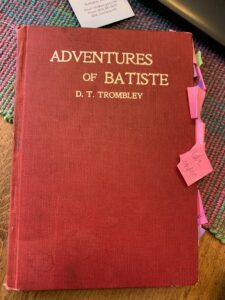
And so he’d go through it. In recent years I’ve written the stories and decoded them in writing for my grandchildren. Because times have changed little and *they* have to know these things.
Jeanie: This is reminding me of The Talk. Which is what a lot people of color talk about the conversations they have to have with their children
about the police or about being Black in public, right?

And so it’s reminding a little bit of that, actually a lot of that.
I’m having this like waves of emotions as you’re talking about this Judy so I’m just doing a check here with you. I’m hearing this like cleverness, this like really amazingly brilliant approach to communicating in code with a whole community of people. Which is so clever and interesting. And I’m hearing about story, which also just delights me.
Then I’m hearing about… this push for willful assimilation to survive? And like the way in which people are teaching their children to hide culture for their survival. And that’s just filling me with grief.
Judy: It is sad. Those are things Batiste Parvenu addresses, in the scenarios that Daniel Trombley has written. Parvenu is not really a last name. It means “the one who puts on airs”. And he puts on airs to survive.
He applies for a job in Chicago, in one of the stories. And he goes in for the interview, and the lady asks him what is his name, he says, “Batiste Pavernu and don’t you forget.” And she goes, “What nationality are you?” And he says, “I’m Irish.” Well, because in Chicago at the time, being Irish would get you the job; not being French. French would not get you the job.
So he puts on these airs. The stories are bumbling. And back home here during that time, many Francos were anglicizing their names. Riviere became River, and so on and so forth. But you get the idea.
Jeanie: This leads me to the next quote. This title Hidden Roots and all of the ways that Indians are, that the Abenaki are hiding in plain sight. This need to hide and assimilate.
The next quote I had picked out was just about that same idea. Uncle Louis has taken Howie out into the woods and they’re praying together. He’s introducing Howie to this way of praying. And I believe they’re watching the sunrise as they pray. He says,
“Is it all right, us praying like Indians that way?” I asked Uncle Louis as we were climbing back down the mountain.
“Long as no one sees us,” he said.
That feels really relevant given your story of your kitchen junkets. And of the advice on how to assimilate, hiding in plain sight, and the newspaper. It made me wonder, knowing you and the scholar you are on the eugenics movement in Vermont. I guess you’ve already answered this to some degree, about the impact that eugenics had on the identity of Abenaki people in Vermont.
Judy: Well, a lot didn’t self-identify for safety reasons. So it’s left future generations floundering on the fact of who they are.
The previous generation tried to hide a lot of things to protect people. These generations find it difficult to find the documentation to prove who they are. To prove how they lived. And they also get confused with the eugenics record.
So there’s both positive and negative records in the eugenics records, and the Vermont Eugenics records. What a good family would look like and what a family that was defective, dependent and delinquent would look like.
So many times, when people see their name in the record they’re like, “Oh I have to be Indian, I was in the records.” But they were not in the records for the reasons the eugenicists were targeting people. They were in for other reasons. So their lack of knowledge totally impacts their direction in life in reclaiming who they are.
Jeanie: So what I hear you saying is that just because your name is written down in the records as one these three Ds doesn’t mean that your family was Abenaki. It could mean that they were just poor. That they lived in a way that was not condoned by the popular morays and norms of the time. Or that they were French-Canadian.
Judy: Correct. The three Ds were the negative eugenics, right. In searching for three Ds they were looking at immigrants or people they deemed to be immigrants. Like French-Canadians, French-Indians, African-Americans.
When you look at history, from Burlington north, that was part of New France. So they weren’t really immigrants. This was their traditional homelands, right. For the Abenaki and the French-Canadians.
I’ve heard anthropologists talk before that anyone north of Route 2 with a French surname is probably from French-Indian descent. So those were the people, after the Flood of 27, who were poor, and struggling and had lost their homes in some cases, because they lived near the rivers. Were struggling. Henry Perkins was constantly writing in the newspapers that they were ruining his views. And I’m like shocked because these people are struggling, and so he desperately wanted them removed.
Jeanie: This just reminds me too, of the power of words, right? I think a lot about that term intergenerational poverty. That that phrasing blames the victims. That blames the people who are impoverished. What if you instead turn this — and I’ll give credit to Paul Gorski for this — to intergenerational economic injustice. How that shifts where the locus of control, where the blame is put. I think I’m thinking about how we continue in this country to this day to criminalize poverty.
Judy: We do. And everyday there’s more and more laws that are passed that perpetuate this intergenerational poverty. They want it to continue. That’s the only way upper class will survive if there’s poverty because they become the workers.
This [recent] twist with the immigrants and slowing down the people coming over our southern border is not new. In 1924, Calvin Coolidge from Vermont passed laws to limit immigration. He passed laws to turn ships back filled with Jews seeking asylum.
So every time a new law is created, it limits what’s within the borders of this “experiment”, if that’s what you want to call it. This thought of a melting pot? Where all people come in from all different cultures into the pot and are mixed and boiled and come out together red, white and blue Americans, is interesting to me.
My father and my grandfather were plumbers. And as a child my job was to take the melting pot, and to take the metals that they used, and melt them in the pot. And the pure sunk to the bottom, and the impurities floated to the top. My job was to scrape out the impurities so only the pure were left in the pot.
So a true melting pot is doing exactly what they had thought, which is to mix all these people together. Create laws to control them, and the pure will be left in the pot.
Jeanie: I never thought of that image that way. Thank you… or not.
Judy: It’s frightening isn’t it?
Jeanie: Well, I think just what you said about criminalizing poverty as well, right? Like, our economic system creates poverty and then criminalizes it, right? We can’t have it both ways, we can’t both create it then tell those folks they’re wrong.
Judy: Well we *can* have it because it’s existing. We *shouldn’t* have it.
Jeanie: I agree. Thank you for that.
One of my favorite parts of this book is as Howie begins to sort of wake a little bit and question his beliefs. It’s on page 82 and I got to admit it’s because I’m a librarian. The librarian has given him The Last of the Mohicans and he says,
I am pleased to say we have many better choices these days, I think. Not as many as we would hope necessarily but there are a lot of better choices for young adult and middle grades and picture books. Do you have any that you would recommend besides the ones you’ve recommended earlier?
Judy: Sure. Actually I’m smiling because the soundtrack from the movie “Last of the Mohicans” was the song my son listened to before he went into wrestling matches in high school. It was something that motivated him to get in there, into the mats, and battle. So I’m chuckling to think that he read The Last of the Mohicans.
For books, there’s so many I can think of. It’s difficult for teachers sometimes to find just the right books. But there’s a website called Oyate. There they carry books written by Native people and reviewed by Native people for cultural appropriateness and historical accuracy.
There’s also several books. One called Through Indian Eyes and one called A Broken Flute, edited by Doris Seale and Beverly Slapin. Those two books are filled with reviews on what’s a good book, what isn’t a book. Doris was from Guilford, Vermont.
She was one of those people who spent their first three years of her life living in a tent on Broad Brook. Her mother died of polio, her father was institutionalized at Brattleboro Retreat because they believed he couldn’t take care of the three girls. The girls were sent to Kurn Hattin during this period of time.
Doris was raised in an institution. Those two books, A Broken Flute and Through Indian Eyes, have a lot of that perspective written into the reviews that Doris did. I think those would be great resources for anybody.
Also, there are two books by Lisa Brooks. One is called The Common Pot and the other one is called Our Beloved Kin. Those two are also good resources in understanding King Philip’s War. Understanding the land that we live on and the connection that Gedakina or this land played with the role that played with King Philip’s War.
Jeanie: Those are great suggestions. One of the things that I have learned from you, Judy, is just because a book features a main character who is Native or Native American, Indian, or Abenaki, doesn’t mean that it’s a book you want in your classroom. I wondered if you could talk through some of the things you’re looking for, if you’re thinking about whether it’s a good representational book, or a book you’d want kids exposed to.
Judy: Yes, I think it’s a matter of learning how to identify the difference between a book that’s appropriate and a book that’s not appropriate.
You want to look for books where Indigenous people are not objectified. You want to look for books where the text reflects language used by both Indigenous people and non-Indigenous people equally. So one is not a “warring savage” and one is just a “warrior”; they’re both warriors. Illustrations that depict not just the past, or people with bright red or bright orange faces. You want to reflect differences in color, size and whatever. Let’s see. The text, the illustrations, vocabulary — you want to look at all of that.
Jeanie: This is super helpful. It reminds me of good friends of mine back when I was in college. When Halloween would come, and people would dress up, this was in the 1990s although folks still do it, would dress up like an Indian. (I’ve got some air quotes around that.) My friend Joe Morales would say, “What are you wearing, blue jeans?” Like sort of this, the way we stick some people in the past is its own kind of erasure. And assume that they still dress a certain way that is primarily just propaganda in our textbooks.
Judy: Right. The other thing which you’re alluding to is stereotypes. I can’t tell you the books so filled with stereotypes that I just want to be ill over.
I’m thinking of — I can’t get it out of my mind right now — is Jodi Picoult’s book called Second Glance. I think I counted like 12 stereotypes that are carried throughout the book. She says she based that book on Nancy Gallagher’s book but I don’t see where she even read one word of it. There’s nothing historically accurate in what she portrays in the book but then again it’s fiction.
Jeanie: I think you get at something interesting. I’ve thought a lot about how stereotypes aren’t just sort of the on-the-warpath kind of Indian stereotype. Also the noble savage or the docile squaw, are stereotypes. Even if they seem like, “Oh, there’s nothing wrong with that.” It portrays this one way, or this dual way of being.
Judy: Or being relentlessly environmentally concerned. Or the drunken Indian, or the lazy Indian, or the ignorant Indian. Those are all stereotypes you often see in books that cause trauma in people.
It’s the same subjective language that was used during the eugenics period. It’s one thing to hear it, it’s another to see it permanently written, in black and white. So that’s why I started all this research and started documenting some of this stuff for my grandchildren. They need to know it’s subjective. That it’s people that hate. It’s people that don’t want to see that there’s a difference and don’t want to embrace those differences.
Jeanie: So that makes me also think about the importance then of #OwnVoices stories like Joseph Bruchac. This is an #OwnVoices story, isn’t it?
Judy: Own voice?
Jeanie: Meaning that the people, the characters are being written about by somebody who shares their ethnic identity with them.
Judy: Yes, you have to feel safe in order to share that. And that goes back to what I said about my father, he did not want me to share it. He was worried for me.
For a while so was I. But then when I reached to a point of being a grandmother, things changed. I felt I needed to be more of an activist. To help protect the lives that they’re going to lead. And keep the lifeways alive for their children, their grandchildren.
They say when you’re looking at seven generations, you should put yourself in the middle and your actions and your words should look backwards three generations and forward three generations. How your actions and your words might impact all of those generations.
Jeanie: You’re definitely looking forwards.
Judy: I am now, at this point in my life, yes.
I think when I was younger and my kids were little it was like, one day at a time. I just got to get through this day. *laughs* But now I’m looking more towards trying to correct the errors that were done in the past in Vermont. Trying to look forward to future generations and having to create an understanding.
Jeanie: I’m so glad you’re doing this work.
I’m going to pull us back to Howie a little bit in Hidden Roots. The first time I read this book was a really long time ago. I really liked it, it’s a quiet little book in a lot of ways. It’s quiet on the surface and then there’s a lot of noise deep down, right. In the family trauma, in the history.
Since that first time reading it and this time, I’ve actually learned a lot more about eugenics. Specifically, from you, in doing a eugenics bus tour around Burlington. And hearing you talk about your scholarship. So re-reading it, having learned from you and having done a little more reading about eugenics, made it a very different experience for me.
So my question for you is, how would you recommend that teachers teach this book in the classroom or use this book in the classroom?
Judy: Well I think I’ll start with this: a lot of teachers don’t want to use this book because of the violence from the father, from Jake. They don’t want to be put in a place to address violence. I think that in this particular case, this is a lesson on historical trauma, generational violence. In order to address and understand it, the book really helps. That would be one thing I would do.
I’ve done several projects with several schools. For instance with Cory Sorenson in Guilford Elementary School. We researched who the eugenicists were from their surrounding area. Then we went to the library and we used primary sources to do research to find out where they lived, what their job was, and a few other details.
So the students learn that the eugenicists were like, the principal of the high school, or a judge, or a lawyer. They learned many different things. And then we took the addresses, got on a school bus, rode around town and found the addresses and marked them. Created waypoints with a GPS.
Then we went back to the classroom, created digital maps. And we created pneumonic devices to help them retell the story of the person they studied. They might weave into a basket or burn on a piece of leather or create some kind of map. Some kind of story that helps them to record and talk about the untold story that they uncovered.
And that was a very fruitful event. We did some amazing things in that class. The kids learned some amazing stories and they did original research, which was phenomenal. And they were only in fourth grade but they knew right from wrong. They knew very basics and I didn’t have to go into detail on some of the words like “sterilization”. I’m like, they just made it so they can’t have babies anymore.
I think these difficult topics are often put on the shelf and passed over because teachers are afraid to address them.
Another thing I recently did was with an eighth-grade class. I sat up four stations, divided the class up. The teacher and I worked together at this. I got all of these primary sources and placed them at each table with a list of questions that could be answered from their primary sources.
I gave them a 10-minute overview of eugenics with the PowerPoint. Then they had to research the questions and finish the story and report back to the class.
That was a simple 70-minute program. They were able to use the primary sources to answer the questions, retell the story to the rest of their classmates. And they had the complete story of the Vermont Eugenics Survey. They had used primary sources, they had done the research themselves. It was kind of an exploration and discovery event for them.
Jeanie: This feels so important to our real understanding of Vermont. And also teaching kids this darker history of Vermont, this history that we’re not as proud of, we’re definitely not proud of. It feels like preparation for understanding when we’re at danger of traveling these paths again.
One of the things I often struggle with or find problematic is that in just about elementary school across this country, there’s always the Native American unit. It’s often in fourth grade, right. Maybe it’s around Thanksgiving time.
There’s the like, “Well, we do the Native American Unit. One group studies the Hopi and another group studies the Cherokee.” I guess I’m asking you for advice about this and for your perspective on how we might do better.
Judy: I don’t see myself as a unit of study.
However, I’m very pleased with the passing of H.3, and the study of ethnic studies. I do see my ancestors as scientists, mathematicians, artists, and historians.
So this gives me an opportunity to show teachers how to do that. Going into the classroom and saying, look at these complex games that talk about probability and odds. Look at this issue of eugenics. The Native technology they created with the changes in flora, fauna, climate, and geology from the Paleo-Archaic and woodland. And the adaptation that occurred at the contact period.
These people were brilliant. If you don’t believe me look around the world today because a lot of their technology is still being used.
So that’s why I’m pleased with the passing of H.3. We’re hoping to have a conference in the spring at the Brattleboro High School to share some of these experiences. I’ve talked with several people at the Vermont Coalition and we’re hoping they can come and share standards with us at the same time.
Jeanie: If folks want to learn more, should they look at the Gedakina website?
Judy: Yes. We’ll post it there as will probably the Brattleboro School District.
Jeanie: Great. Do you have anything else that you could recommend to Vermont educators? Any other words of wisdom for us about this book in particular or just about how we could bring the Abenaki, the people whose lands we’re on, into our classrooms?
Judy: There’s a lot of important things but the first is to look at… to not look at them as generic. So the example you gave like the Southeast and the Southwest and the Northwestern? Dividing your classes up into those groups can be problematic because teachers often say, “Oh, let’s study what their lodges looked like. What food did they eat? How did they dress?”
So they address differences, but they leave us dangling back 500 years ago.
Teachers usually do this with the age group that’s learning about timeline. So if you end us back at 500 years ago and don’t say we live in apartments, and condos, and trailers, and houses today? There’s a big gap in the story that you’re asking them to learn.
That would be the first thing I would say. I think there are other things. To understand that there’s not a generic Indian. And that each nation is different in many ways, with their ethics, morals, values, and beliefs. Those things are critical to who they are and how they live.
I think eugenics is often twisted and distorted. The primary sources are available at the state archives. So I think whenever possible it’s great to use primary sources to figure it out yourself.
If we want our children to form an opinion, as core curriculums states, we can’t just give them our opinion. We have to give them the opportunities to use resources that help them to form their opinions so they hear from all sides, all perspectives.
Jeanie: What I hear from you is not to teach them history but to teach them the tools of being a historian.
Judy: Yes.
Jeanie: You’ve taught me a lot about the eugenics movement and the way you used primary sources and used maps and other documents to really tell the story of eugenics in Burlington. And kids could do that in their communities.
Judy: They can. I sort of look at education as a form of exploration, experiences, and observations. If we asked them to do those things and give them the tools to do them, they’re going to be able to develop their own opinion in a more balanced way.
Jeanie: Yes, in an informed way. That’s wonderful. Oh, Judy, I could talk to you forever. Are there any other last words you want to leave us with?
Judy: I just want to inform people that they too need to form an opinion and it could be life-changing.
Jeanie: We have to continue to pay attention.
Judy: We do, every day.
Jeanie: Vigilance.
Judy: Yup.
Jeanie: Thank you so much for taking the time, for inviting me into your wonderful home, with all of your art and your pottery and your… Judy is an incredible artist you guys.
With all of this beautiful… what’s the word I’m looking for? This beautiful evidence of who your and how you carry yourself in the world. I’m so grateful to be here. Thank you.
Judy: Thank you:
Jeanie: I’m Jeanie Philips and this is has been an episode of #vted Reads, talking about what Vermont’s educators and students are reading. Thank you so much to Judy Dow for appearing on this show and talking with about Hidden Roots. If you’re looking for a copy of Hidden Roots, check your local library. To find out more about #vted Reads including past episodes, upcoming guests and a whole lot more, you can visit vtedreads.tarrantinstitute.org. Follow us on Twitter and Instagram at @vtedreads. This podcast is a project of the Tarrant Institute for Innovative Education at the University of Vermont.
Judy: You know what, would work nicely at the end is that poem.
This poem came to me in a dream. I have a presentation at a museum in Queens right now on eugenics. I’m going to present to the students and the docents who are 80 and 90-year old Jews that work at this museum.
So I had this brainstorm of creating this poem. I ran it by my dear friend Verandah Porche who is a poet. I said, “Here’s my outline, here’s my audience, here’s my story. Will you help me make this into a poem?”
So I’d like to read to you what we have now.
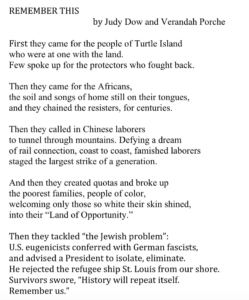
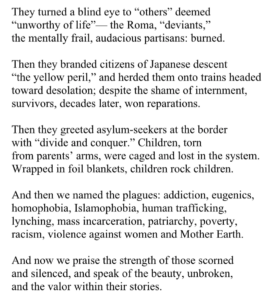
Jeanie: That was beautiful.
Judy: Thank you.
Jeanie: Thank you.
Judy: That fits, doesn’t it?
Jeanie: It really does.


